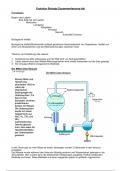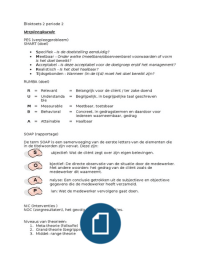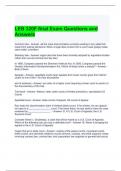Financial stability risks related to
climate change
Climate change and the transition to a more sustainable economy could contitute risks for the
financial services sector and financial stability, if the related risks are not anticipated and factored in
appropriately by the institutions in their risk management processes.
1. Climate change risks
The FSB has estimated that the VaR to the amount of financial assets subject to direct climate risks or
transition risks by the end of the century ranges from 4200 to 43000 billion USD indicates
potential importance of these risks
Two major categories of risks:
Physical impact of climate change (phisical risks)
= arise from climate and weather related events such as floods and storms
o Operational risks: damages to physical infrastructure
o Market, credit and liquidity risk: through loans to retail and corporate customers or
their investment portfolios climate related losses trigger write downs of their
assets
o Higher claims for insurance companies
o Systemic risks: lower productivity, economic disruption, sovereign default risk
Transition to a low carbon economy (transition risks)
o Implies a shift away from fossil fuels and related physical assets
o If actions are postponed, there will be an abrupt transition which leads to losses
through direct exposure to carbon-intensive industries
o Important to have a transparant view of exposure to sectors such as oil, gas etc.
o Abrupt transition has impact on macroeconomic variables such as inflation GDP
growth, consumption as well
Gives rise to concerns about financial stability (markets are vulnerable to abrupt
corrections)
Green finance: there are significant investment opportunities for banks and insurance companies
Reallocation of resources
Technological revolution
New Risks : can cause financial bubbles (optimistic expectations by financial markets)
Reputational damage & liability losses through greenwashing: financial instuments turn out
to be less green than they appeared
2. Climate related risks in Europe
Estimating associated economic and financial losses is very difficult
Estimated var to the global stock of manageable assets: range 4300 to 43000 billion
o Reflects different scenario’s
Majority of impact through weaker economic growth and lower return on financial assets
There is an upward trend in the economic losses due to global disasters, but it is very difficult
to isolate the role of climate change in these losses
, In Europe an overall increase in losses resulting from weather related events is expected in
the future
Exposure of financial institutions to climate risks in the Netherlands:
Physical risks: foreign assets are in countries that can deal with climate change. They are
exposed to flood events (credit losses and losses through secondary channels)
Transition risks: exposure to carbon intensive sectors ranges from 12 % of total assets for
pension funds to 11% for banks and a lower 4.5% for insurers
3. Belgian financial sector exposure to climate related
systemic risks
Physical risks
Impacts mainly insurance companies:
liabilities directly exposed through property and vehicle related business
Rising claim burdens in case of extreme weather related events
Puts pressure on stability of Belgian insurance sector
Belgium: overall increase of 2° in average temperature and flooding due to heavy rainfall
Sizeable impact on Belgian insurers p & l accounts (Chart 1 p 144)
Asset side of financial institutions balance sheet:
Hold investment or loan portfolio’s in area’s that could be severely affected by climate
change
You can identify the countries with the highest vulnerability to climate change risk with the
ND-Gain index (consisting of 45 variables, mitigation, population living below 5metres,
contribution of agricultural sector to GDP)
Belgium: Lions share of Belgian banks and insurance companies exposures are located in
countries where the impact of global warming can be expected to be lower. (chart 2 p 145)
Transition risks
The asset quality of assets deteriorates due to transition risks
Belgium: 30 % of the banks’ corporate loan portfolio and 24% of the insurance companies
corporate bonds, itc. Had counterparties in high-energy-intensity sectors. (chart 3 p146)
Transition risk through mortgage loan portfolio: heating cost increase affects the mortgage
debt repayment ability
Belgium: half of all residential buildings were constructed before 1970 share of energy-
intensive properties is quite considerable
4. Green finance: financing the transition to a low
carbon economy
New opportunities for financial institutions:
Mortgage loans for renovations (20% of total in Belgium) due to increased regulatory
requirements regarding ecological building
Transition to decarbonised economy requires infrastructure investments and brigs up new
financing opportunities
Growing demand for green financing opportunities
climate change
Climate change and the transition to a more sustainable economy could contitute risks for the
financial services sector and financial stability, if the related risks are not anticipated and factored in
appropriately by the institutions in their risk management processes.
1. Climate change risks
The FSB has estimated that the VaR to the amount of financial assets subject to direct climate risks or
transition risks by the end of the century ranges from 4200 to 43000 billion USD indicates
potential importance of these risks
Two major categories of risks:
Physical impact of climate change (phisical risks)
= arise from climate and weather related events such as floods and storms
o Operational risks: damages to physical infrastructure
o Market, credit and liquidity risk: through loans to retail and corporate customers or
their investment portfolios climate related losses trigger write downs of their
assets
o Higher claims for insurance companies
o Systemic risks: lower productivity, economic disruption, sovereign default risk
Transition to a low carbon economy (transition risks)
o Implies a shift away from fossil fuels and related physical assets
o If actions are postponed, there will be an abrupt transition which leads to losses
through direct exposure to carbon-intensive industries
o Important to have a transparant view of exposure to sectors such as oil, gas etc.
o Abrupt transition has impact on macroeconomic variables such as inflation GDP
growth, consumption as well
Gives rise to concerns about financial stability (markets are vulnerable to abrupt
corrections)
Green finance: there are significant investment opportunities for banks and insurance companies
Reallocation of resources
Technological revolution
New Risks : can cause financial bubbles (optimistic expectations by financial markets)
Reputational damage & liability losses through greenwashing: financial instuments turn out
to be less green than they appeared
2. Climate related risks in Europe
Estimating associated economic and financial losses is very difficult
Estimated var to the global stock of manageable assets: range 4300 to 43000 billion
o Reflects different scenario’s
Majority of impact through weaker economic growth and lower return on financial assets
There is an upward trend in the economic losses due to global disasters, but it is very difficult
to isolate the role of climate change in these losses
, In Europe an overall increase in losses resulting from weather related events is expected in
the future
Exposure of financial institutions to climate risks in the Netherlands:
Physical risks: foreign assets are in countries that can deal with climate change. They are
exposed to flood events (credit losses and losses through secondary channels)
Transition risks: exposure to carbon intensive sectors ranges from 12 % of total assets for
pension funds to 11% for banks and a lower 4.5% for insurers
3. Belgian financial sector exposure to climate related
systemic risks
Physical risks
Impacts mainly insurance companies:
liabilities directly exposed through property and vehicle related business
Rising claim burdens in case of extreme weather related events
Puts pressure on stability of Belgian insurance sector
Belgium: overall increase of 2° in average temperature and flooding due to heavy rainfall
Sizeable impact on Belgian insurers p & l accounts (Chart 1 p 144)
Asset side of financial institutions balance sheet:
Hold investment or loan portfolio’s in area’s that could be severely affected by climate
change
You can identify the countries with the highest vulnerability to climate change risk with the
ND-Gain index (consisting of 45 variables, mitigation, population living below 5metres,
contribution of agricultural sector to GDP)
Belgium: Lions share of Belgian banks and insurance companies exposures are located in
countries where the impact of global warming can be expected to be lower. (chart 2 p 145)
Transition risks
The asset quality of assets deteriorates due to transition risks
Belgium: 30 % of the banks’ corporate loan portfolio and 24% of the insurance companies
corporate bonds, itc. Had counterparties in high-energy-intensity sectors. (chart 3 p146)
Transition risk through mortgage loan portfolio: heating cost increase affects the mortgage
debt repayment ability
Belgium: half of all residential buildings were constructed before 1970 share of energy-
intensive properties is quite considerable
4. Green finance: financing the transition to a low
carbon economy
New opportunities for financial institutions:
Mortgage loans for renovations (20% of total in Belgium) due to increased regulatory
requirements regarding ecological building
Transition to decarbonised economy requires infrastructure investments and brigs up new
financing opportunities
Growing demand for green financing opportunities










